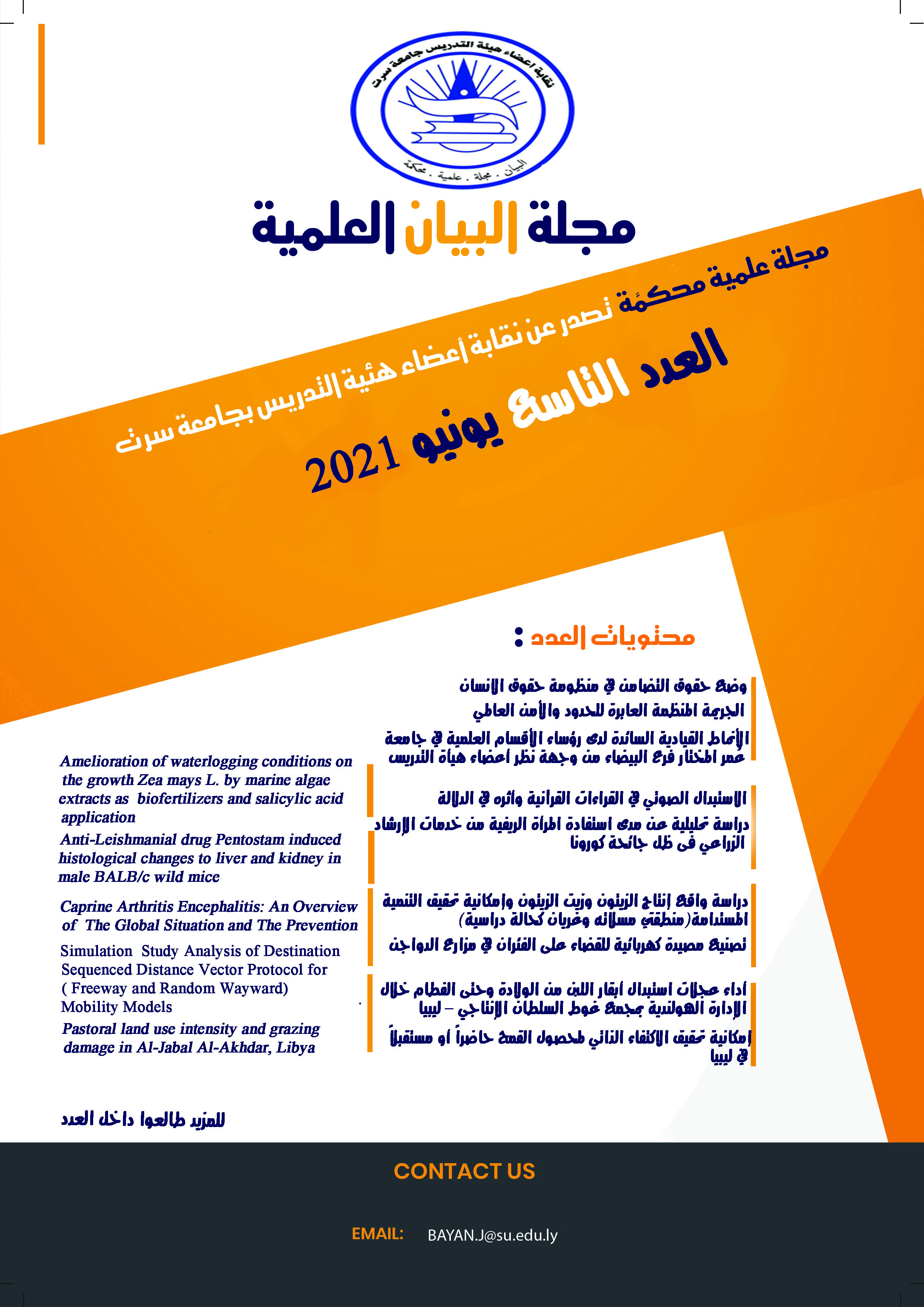Evaluate the effect of using source of nitrogen as urea and a rice wash water (RWW) on the chemical composition, fatty acids and amino acids for marine microalgae Nannochlorpsis oceanica
الكلمات المفتاحية:
الأحماض الأمينية ،، الأحماض الدهنية ،، نانوكلوربسس أوشينيكا ،، التركيب الكيميائي .الملخص
تقييم تأثير استخدام مصدر النيتروجين مثل اليوريا ومياه غسل الأرز (RWW) على التركيب الكيميائي والأحماض الدهنية
والأحماض الأمينية للطحالب البحرية الدقيقة نانوكلوربسس أوشينيكا
يجب أن تكون وسائط تربية الطحالب المجهرية فعالة من حيث التكلفة ، وتمكن من النمو العالي ، وتفي بالمتطلبات الدقيقة وتكون متاحة بسهولة. تم تقييم تأثير المستويات المختلفة من اليوريا وماء غسيل الأرز [25 و 50 و 75٪] في وسط النمو على المكونات البيوكيميائية (البروتين والكربوهيدرات والدهون والأحماض الدهنية والأحماض الأمينية) في نانوكلوربسس أوشينيكا مقارنة مع الوسط القياسي F / 2 Guillard. أوضحت النتائج المتحصل عليها أن المكونات الكيميائية لنوع نانوكلوربسس أوشينيكا قد تأثرت بمستوى اليوريا المستخدم وماء غسيل الأرز. تم الحصول على أعلى نسبة بروتين ، ومحتويات كربوهيدرات ، وأعلى نسبة من الأحماض الأمينية الأساسية (EAA) (55.16٪) باستخدام وسط MF3 (75٪ RWW) مقارنة بالكنترول (100٪ F / 2). تم تحقيق أعلى محتوى إجمالي للدهون باستخدام وسط MF3 (75٪ RWW) ينتج (41.72٪) ، حيث تم الحصول على أعلى إنتاجية للكتلة الحيوية وإنتاجية الدهون في وسط MF3. وفقًا لذلك ، تم تسجيل أعلى نسبة إجمالي للأحماض الدهنية المشبعة (TSFA) من نانوكلوربسس أوشينيكا بواسطة وسط MF3. ومع ذلك ، تم عرض أعلى نسبة إجمالية للأحماض الدهنية غير المشبعة (USFA) بواسطة وسط MF3.
أوصت الدراسة الحالية بنتائج التربية للإستخدام في الإستزراع المائي باستخدام وسط MF3 و MF2 كمحفز للدهون وكمحفز للبروتين.
المراجع
REFERNCES:
Aarón Millán-Oropeza, Luis G. Torres – Bustillos and Luis Fernández-Linares, (2015).
Simultaneous effect of nitrate (NO3-) concentration, carbon dioxide (CO2) supply and
nitrogen limitation on biomass, lipids, carbohydrates and proteins accumulation
inNannochloropsis oculata Biofuel Research Journal 5 , 215- 221.
Abomohra, A., Wagner, M., El-Sheekh, M., Hanelt, D. (2013) Lipid and total fatty acid
productivity in photoautotrophic fresh water microalgae: Screeningstudiestowards biodiesel
production. Journal of Applied Phycology, 25, 931-936.
Abomohra,A.W. Jin, R.Tu, S.Han, M.Eid, and H.Eladel, (2016). Microalgal biomass
production as asustainable feedstock for biodiesel :current statusand perspectives,
Renew.Sustain.EnergyRev.64(2016)596–606.
Abugrara, A.M., El-Sayed, H.S., Zaki, M.A., Nour, A.M. (2019). Some Factors Affecting
on Growth, Production of Marine Microalgae and Relation to Fish feeding. M.sc. Thesis,
Faculty of Agriculture. El-Shatby, Alexandria University Department of animal and fish
production.
Abugrara Ali M. , Hanan M. Khairy, Heba S. El-Sayed and Hoda H. Senousy, (2020). Effect
of Various Bicarbonate Supplements on Biodiesel Production and Valuable Biochemical
Components of the Marine Eustigmatophyceae Nannochloropsis oculata (Droop)Egypt. J.
Bot. Vol. 60, No.3, pp.
Ashour M and Abd El-Wahab K, (2017). Enhace growth and biochemical composition of
Nannochloropsis oceanica, cultured under nutrient limitation, Using Commercial
Agricultural Fertilizersm J Marine Sci Res Dev, 7:4.
Ashour M.,,MostafaE.Elshobary,RaniaEl-Shenody,Abdel-WahabKamil, and AbdEl-
FatahAbomohra.,(2019). Evaluation of a native oleaginous marine microalga
Nannochloropsis oceanica for dual use in biodiesel production and aquaculturefeed.
Biomass and Bioenergy 120, 439-447. Journal homepage: www.elsevier.com/locate/biombio
Bajpai R, Prokop A, Mark Z (2014). Algal Biorefineries. Springer Science, Business Media
Dordrecht. Library of Congress Control.
Becker E. W. (1994). Microalgae Biotechnology and microbiology. Cambridge University
Press, Cambridge.
Biondi N., N. Bassi, G. Chini Zittelli, D. Faveri, A. Giovannini, L. Rodolfi, M.R.
(2013).Tredici, Nannochloropsis sp. F&M-M24: oil production, effect of mixing on
productivity and growth in an industrial wastewater, Environ. Prog. Sustainable Energy 32
(3) 846–853.
Piggott, J.J., Salis, R.K., Lear, G., Townsend, C.R. and Matthaei, C.D. (2015). Climate
warming and agricultural stressors interact to determine stream periphyton community
composition.Glob. Chang. Biol. 21, 206–222.
Block, R.J. (1948) Quantitative estimation of amino acids on paper chromatograms. Science,
, 608609.
Bligh, E.G., Dyer, W.J. (1959). A rapid method for total lipid extraction and purification.
Canadian Journal of Biochemistry and Physiology, 37, 911-917.
Bondioli P, Laura DB, Gabriele R, Graziella CZ, Niccolo B, et al. (2012).Oil production by
the marine microalgae Nannochloropsis sp. M-M24, Tetraselmissuecica M-M33. Bioresource Technology 114: 567-572.
Cai,T., Park, S. y. and Li,Y. (2013). Nutrient recovery from wastewater streams by
microalgae : status and prospects. Renew. Sustain. Energy Rev. 19:360-369.
Carvalho, G.G.P.de, Pires, A.J.V., Garcia, R., Veloso, C.M., Silva, R.R., Mendes, F.B.L.,
Pinheiro, A.A., Souza, D.R.de. (2009). In situ degradability of dry matter, crude protein
and fibrous fraction of concentrate and agroindustrial by-products. Ciência Animal
Brasileira, 10, 689-697.
Dubois, M., Gilles, K.A., Hamilton, J.K., Rebers, P.A., Smith, F. (1956) Colorimetric
method for determination of sugars and related substances. Analytical Chemistry, 28, 350-
Folch, J., Lees, M., GH, S.S. (1957). A simple method for the isolation and purification of total
lipides from animal tissues. The Journal of Biological Chemistry, 226, 497-509.
Grobbelaar, J.U. (2010). Microalgal biomass production: Challenges and realities.
Photosynthesis Research, 106, 135-144.
Guillard RLL , Rhyter JH (1962) Studies on marine planktonic diatoms I. Cyclotella nana
Hustedt , Detonula confervacea (Cleve). Grans Can J Microbiol 8: 229-239
Hemaiswarya, S., Raja, R., Carvalho, I.S., Ravikumar, R., Zambare, V., Barh, D.
(2011). An Indian scenario on renewable and sustainable energy sources with emphasis
on algae. Applied Microbiology and Biotechnology, 96, 1125-1135.
Ho, S.H., Ye, X., Hasunuma, T., Chang, J. S. and Kondo,A. (2014). Perspectives on
engineering strategies for improving biofuel production from microalgae :a critical
review. Biotechnol. Adv. 32:1448-1459.
Huerlimann Roger, Rocky de Nys and Kirsten Heimann, (2010). Growth, Lipid Content,
Productivity, and FattyAcid Composition of Tropical Microalgae forScale-Up Production
Wiley Online Library (wileyonlinelibrary.com). DOI 10.1002 /bit. 22809.
Jean Hee Bae and Sung Bum Hur (2011). Development of Economical Fertilizer-Based
Media for Mass Culturing of Nannochloropsis oceanica Fish Aquat Sci 14(4), 317-322 .,
Lopez-Elıas JA, Domenico V, Fern EO, Griselda GS (2005) Indoor, outdoor mass production
of the diatom Chaetoceros muelleri in a mexican commercial hatchery. Aquacultural
Engineering 33: 181-191.
Lowry, O.H., Rosebrough, N.J., Farr, A.L., Randall, R.G. (1951). Protein measurement with
folin phenol reagent. Journal of Biological Chemistry, 193, 265-275.
Madhusree Mitra , Freny Shah , S.V. Vamsi Bharadwaj , Shailesh Kumar Patidar and Sandhya
Mishra.(2016). Cultivation of Nannochloropsis oceanica biomass rich in eicosapentaenoic
acid utilizing wastewater as nutrient resource
Mata Teresa M., Anto´nio A. Martins and Nidia. S. Caetano (2010). Microalgae for
biodiesel production and other applications: A review Renewable and Sustainable Energy
Reviews 14 217–232.
Milledge John James,(2011). Disc Stack Centrifugation Separation and Cell Disruption of
Microalgae: A Technical Note. Environment and Natural Resources Research Vol. 1, No. 1.
Patil V, Reitan KI, Knutsen G, Mortensen LM, and Ka ¨llqvist T., (2005). Microalgae as
source of polyunsaturated fatty acids for aquaculture. Plant Biol 6:57–65
Radwan, S. S. (1978). Coupling of two- dimensional thin-layer chromatography with gas
chromatography for the quantitative analysis of lipid classes and their constituent fatty
acids. Journal of chromatographic science, 16(11), 538-542.
Riebesell, U., Kortzinger, A. and Oschlies, A. (2009) Sensitivities of marine carbon fluxes to
ocean change. Proc. Natl Acad. Sci. USA, 106, 20602– 20609.
Sarker, P.K., Kapuscinski, A.R., Lanois, A.J., Livesey, E.D., Bernhard, K.P., Coley, M.L.
(2016). Towards Sustainable Aquafeeds: Complete substitution of fish oil with marine
microalga Schizochytrium sp. improves growth and fatty acid deposition in Juvenile Nile
Tilapia (Oreochromis niloticus). PLOS One, 11,e0156684.
SPSS (2007) Sigmastat Statistical Software (SPSS), Applied Statistics with SPSS.Templeton, D.W., Laurens. M.L. (2015). Nitrogen-toprotein conversion factors revisited for
applications of microalgal biomass conversion to food, feed and fuel. Algal Research, 11,
-367.
Tokuşoglu, O., Ünal, M.K. (2003). Biomass nutrient profiles of three microalgae: Spirulina
platensis, Cholorella vulgaris, and Isochrisis galbana. Journal of Food Science, 68, 1144-
.
Wan Chun , Xin-Qing Zhao , Suo-Lian Guo, Md. Asraful Alam and Feng-Wu Bai, (2012).
Bioflocculant production from Solibacillus silvestris W01 and its application in cost-
effective harvest of marine microalga Nannochloropsis oceanica by flocculation. Bioresource Technology xxxxxx–xxx.
Wan Chun,Feng-WuBai and Xin-QingZhao (2013). Effectsofnitrogenconcentrationand
mediareplacementoncell growthandlipidproductionofoleaginousmarinemicroalga
Nannochloropsis oceanicaDUT01. BiochemicalEngineeringJournal 78. 32- 38.
Wang Jinghan, Haizhen Yang and Feng Wang, (2013).Mixotrophic Cultivation of
Scenedesmus sp. as Biodiesel Feedstock Advanced Materials Research. ISSN: 1662-8985,
Vol. 777, pp 268-273 doi:10.4028/www.scientific.net/AMR.777.268 © 2013 Trans Tech
Publications, Switzerland .
Wiley Patrick E. , J. Elliott Campbell and Brandi McKuint, (2011).Production of
Biodiesel and Biogas from Algae: A Review of Process Train OptionsWater Environment Research, Volume 83, Number 4.
Zhang Xuezhi , Zhiying Lu , Yifei Wang , Pierre Wensel , Milton Sommerfeld and Qiang
Hu, (2016).Recycling Nannochloropsis oceanica culture media and growth inhibitors
characterization .Algae Research 20,282–290.Journalhomepage:www.elsevier.com/locate/alga
Zhu Y, and Dunford NT., (2013). Growth, Biomass Characteristics of Picochlorum
oklahomensis, Nannochloropsis oculata. J Am Oil Chem Soc 90: 841-849.













